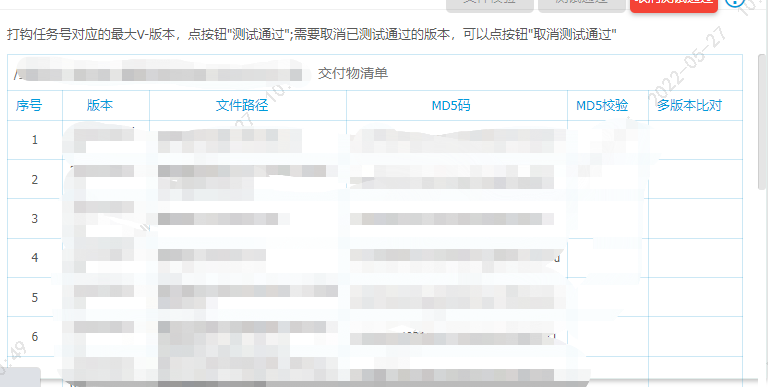背景:
每次发版需要写测试报告,报告中有一项是关于版本号的信息,需要将公司平台页面的表格内容,拼接、粘贴到word。
如图

需求:
将以上图片信息组合成以下文本格式:
系统名称+版本号/文件路径(图片列)
MD5码:MD5码(图片列)
注:系统名称+版本号抓包后在response中可获取
解决代码:
import requests
# 网上找的处理requests库返回json类型(在python接收为多维字典)的方法
def get_target_value(key, dic, tmp_list):
"""
:param key: 目标key值
:param dic: JSON数据
:param tmp_list: 用于存储获取的数据
:return: list
"""
if not isinstance(dic, dict) or not isinstance(tmp_list, list): # 对传入数据进行格式校验
return 'argv[1] not an dict or argv[-1] not an list '
if key in dic.keys():
tmp_list.append(dic[key]) # 传入数据存在则存入tmp_list
for value in dic.values(): # 传入数据不符合则对其value值进行遍历
if isinstance(value, dict):
get_target_value(key, value, tmp_list) # 传入数据的value值是字典,则直接调用自身
elif isinstance(value, (list, tuple)):
_get_value(key, value, tmp_list) # 传入数据的value值是列表或者元组,则调用_get_value
return tmp_list
def _get_value(key, val, tmp_list):
for val_ in val:
if isinstance(val_, dict):
get_target_value(key, val_, tmp_list) # 传入数据的value值是字典,则调用get_target_value
elif isinstance(val_, (list, tuple)):
_get_value(key, val_, tmp_list) # 传入数据的value值是列表或者元组,则调用自身
# 获取版本信息方法
def get_reportinfo(ywpturl, authinfo):
# 必要的header信息
ywptheaders = {
'User-Agent': 'Mozilla/5.0 (Windows NT 10.0; Win64; x64) AppleWebKit/537.36 (KHTML, like Gecko) Chrome/101.0.4951.67 Safari/537.36',
'Cookie': authinfo
}
# 调用查看版本列表接口
r = requests.get(ywpturl, headers=ywptheaders)
# 将接口返回的列表存储,知识点,返回结果在python为字典类型,此字典为多维字典
resraw = r.json()
# 用网上方法获取字典的值,存到数组
md5s = get_target_value('md5',resraw,[])
paths = get_target_value('filedirectory',resraw,[])
filenames = get_target_value('filename',resraw,[])
sysnames = get_target_value('sysname',resraw,[])
print("最终结果是----------------------------------------------------------------------")
# 拼接、组合以上数组,打印输出
for path, filename, md5, sysname in zip(paths, filenames, md5s, sysnames):
print(sysname+path+'/'+filename)
print("MD5码:", md5)
# 设置变量,接收每次版本的请求地址和登录态
url = "http://abc.com/pub/Excel?ftptype=21.0.134.99&morepaths=666666666E766%%%%%86%E4%BF%A1%E6%81%AF%E7%B3%BB%E7%BB%9F"
cookie = 'this.is.token.SESSIONID=youcannotsee'
# 调用获取版本信息方法
get_reportinfo(url, cookie)结果:
